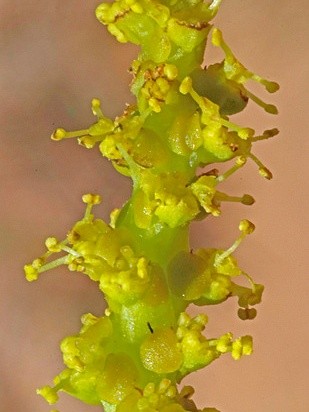Queen's-delight
(Stillingia sylvatica)

Description
Stillingia sylvatica, known as queen's-delight or queen's delight, is a species of flowering plant in the family Euphorbiaceae. It was described in 1767. It is endemic to the south-central and southeastern United States, growing in sandy areas such as sandhills and pine flatwoods. It is an herb or subshrub averaging 25–70 cm (9.8–27.6 in) in height. It has alternate, ovate leaves with short petioles, reaching 10 cm (3.9 in) in length and 3 cm (1.2 in) in width. The leaf margins are serrulate to crenulate with incurved teeth. Each crowded inflorescence has four to seven staminate flowers and three to four pistillate flowers. Queen's delight flowers between March and June, fruiting from April to September. Stillingia is a plant genus of the family Euphorbiaceae, first described for modern science as a genus in 1767. The genus is native to Latin America, the southern United States, and various islands in the Pacific and Indian Oceans. Toothleaf is a common name for plants in this genus. Stillingia sylvatica was used by Native Americans for syphilis and as a cathartic, diuretic, laxative, and emetic. In large doses, it causes vomiting and diarrhea.
Taxonomic tree:







